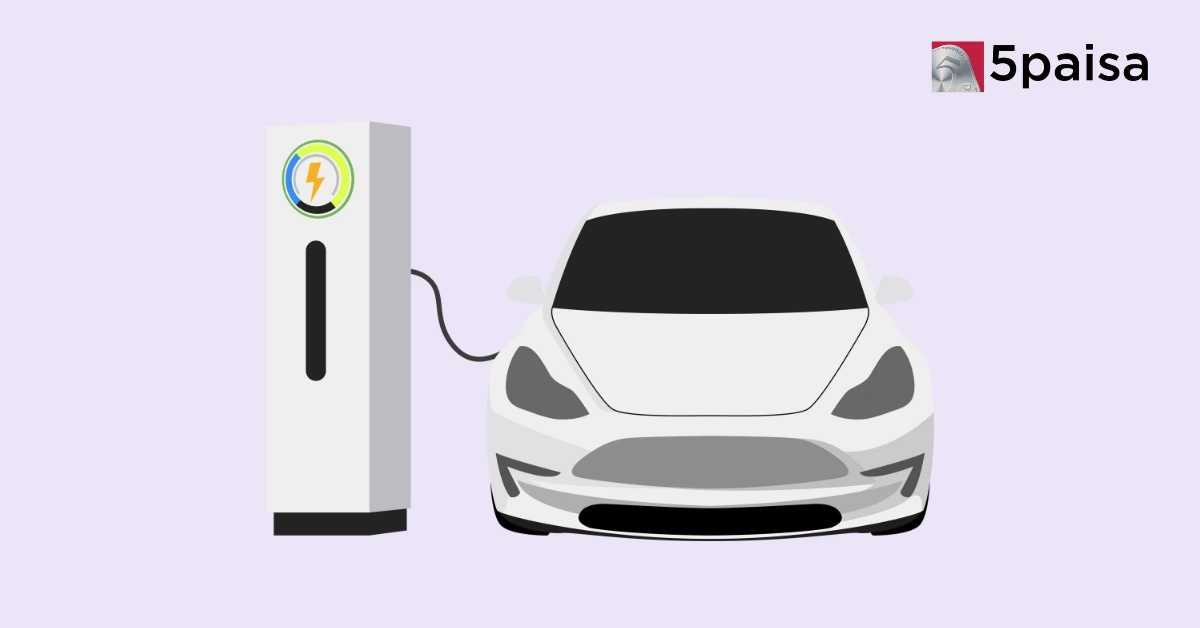5paisa Market Wrap 2025: A Look Back at How India Traded, and How You Participated
Best EV Stocks in India 2025

Last Updated: 25th November 2025 - 05:06 pm
The Indian EV market keeps growing at a rapid pace because the government supports electric vehicle adoption through its EV30@30 initiative and multiple policy benefits. The Indian automotive industry continues to grow its electric vehicle offerings through new model releases from Tata Motors Passenger Vehicles and Mahindra & Mahindra and Maruti Suzuki India. The EV ecosystem receives backing from battery manufacturers Amara Raja Energy & Mobility and Exide Industries and Tata Power which leads the charging infrastructure market.
Investors need to evaluate Indian EV stocks based on their OEM status and battery and energy storage capabilities and component manufacturing and charging utility operations while assessing their EV model development and market position and capital expenditure and financial stability because of their existing ICE business operations. The sector provides long-term expansion opportunities although it faces challenges from regulatory changes and technological advancements and market competition.
Best EV Stocks in India 2025
As of: 26 Dec, 2025 3:55 PM (IST)
| Company | LTP | PE Ratio | 52W High | 52W Low | Action |
|---|---|---|---|---|---|
| Tata Motors Ltd. | 408.65 | 0.00 | 432.30 | 306.30 | Invest Now |
| Mahindra & Mahindra Ltd. | 3623.1 | 31.70 | 3,795.00 | 2,425.00 | Invest Now |
| Maruti Suzuki India Ltd. | 16596 | 35.30 | 16,720.00 | 10,750.10 | Invest Now |
| Bajaj Auto Ltd. | 9064.5 | 30.40 | 9,490.00 | 7,089.35 | Invest Now |
| Hyundai Motor India Ltd. | 2321.1 | 33.00 | 2,890.00 | 1,541.70 | Invest Now |
Best Electric Vehicles Stock in India in 2025: 5-Year CAGR Basis
- Bharat Electronics
- Himadri Speciality Chemical
- UNO Minda
- Tata Motors Passenger Vehicles
- Bosch
The companies have chosen separate approaches to adapt to electric vehicles but they share a common goal of benefiting from expected market growth.
Overview of the Best EV Stocks
The Indian EV sector demonstrates fast growth during its current development period. The companies continue to develop their electric vehicle ranges while they work to achieve profitability. The market performance of these top EV stocks varies significantly between them. Investors need to know which elements make these top EV stocks attractive for their investment portfolios.
Tata Motors Passenger Vehicles
Tata Motors Passenger Vehicles controlled 41.4% of the electric vehicle market during Q2FY25. Tata EV business achieved a 4.2% EBITDA margin during the previous quarter which showed a 920 basis points year-over-year improvement. The company reached 27% annual sales growth during October 2025 while electric vehicle sales recorded growth of 73.4% YoY. The company maintains attractive expansion plans for investors despite facing market volatility and recent financial losses.
Mahindra & Mahindra
Mahindra leads the Indian electric SUV and passenger EV markets through its dominant position which reached 37% in electric SUVs and 33% in passenger EVs during March 2025. The company produces 8,000 EV units monthly at present but aims to reach 12,000 units per month by March 2026. Mahindra leads India's EV market growth through its commitment to launch seven battery electric vehicles by 2030 and its major funding for new EV platform development.
Maruti Suzuki India
Maruti Suzuki used to avoid pure electric vehicles but it now actively supports electric mobility through its e-Vitara electric SUV which entered production in August 2025 with more than 500 km range. Maruti Suzuki plans to introduce four battery-electric vehicles and multiple strong hybrids during FY 2030-31 by using its internal hybrid technology to minimise costs. The company leads its market through its electric vehicle transition which generates major long-term investment potential despite its restricted current electric vehicle offerings.
Bajaj Auto
Bajaj Auto maintains its position as the top electric two-wheeler manufacturer in India through its 21.9% market share in October 2025 thanks to its successful Chetak Urbane and Premium series models. Bajaj Auto kept its market leadership position through festive promotions and GST benefits which enabled them to increase their electric scooter sales. Bajaj Auto maintains its position for future growth in India's two-wheeler EV market through its development of high-performance lithium-ion battery technology and its expansion of electric cargo and passenger EV product lines.
Hyundai Motor India
Hyundai Motor India plans to introduce 26 new models through FY 2030 which will include six battery electric vehicles and specific hybrid models. The company plans to establish 600 public fast charging stations across India during the next seven years as part of its EV infrastructure development. Hyundai Motor India will achieve sustainable growth through its combination of ICE volume maintenance with its expanding EV product lineup which includes the CRETA Electric SUV and hydrogen fuel cell and autonomous driving technologies.
Top EV Stocks in November 2025 – Market Cap Basis
The size of a company and investor trust levels can be measured through market capitalisation. The three companies with the highest market capitalisation are Maruti Suzuki, Mahindra and Mahindra (M&M) and Bajaj Auto.
Best EV Stocks in November 2025 – Net Profit Margin Basis
The evaluation of financial health requires organisations to measure their profit margins. Maruti Suzuki and Mahindra & Mahindra maintain their profitability levels. Tata Motors Passenger Vehicles and Bajaj Auto show consistent business results but TVS Motor Company reaches success through its effective cost management approach. The market stability indicators show stable market performance during market fluctuations so investors need to track these metrics.
Important Factors to Keep in Mind Before Investing in EV Stocks
Investors who want to buy EV stocks need to evaluate multiple essential elements before making their decision:
- The EV sector depends heavily on government regulations and financial incentives to achieve its growth targets. Companies achieve profitability through modifications that government policies introduce.
- Companies need to create new technologies and innovative solutions to achieve their future success.
- The supply chain faces risks because it depends on imported raw materials including lithium and cobalt which affect production costs.
- The EV market faces growing competition because more companies enter the market while established automakers expand their operations in India.
- The EV manufacturing process requires major funding so companies need to maintain their financial stability while building effective cash management systems.
- The EV industry encounters economic difficulties because shifting commodity market prices and currency exchange rates impact both export revenue and manufacturing costs.
The elements of EV market dynamics help investors protect their assets while they look for stable growth potential in this fast-changing industry.
Conclusion
The Indian electric vehicle market shows strong expansion potential because of technological advancements and government backing and increasing customer interest. The EV stocks of Tata Motors Passenger Vehicles and Mahindra & Mahindra and battery specialists Exide Industries and Amara Raja Batteries show promising long-term growth potential based on their financial performance and market value.
Investors need to monitor specific risks affecting the sector while tracking market changes when they create EV investment portfolios for 2025.
The sector presents itself as an attractive investment opportunity in India's expanding equity market. Investors who want to maximise their returns from Indian EV stocks need to maintain long-term investment positions while performing complete fundamental stock analysis.
Frequently Asked Questions
Which Indian company is investing in electric vehicles?
What is the future of EVs in India?
Why are electric cars expensive in India?
Who is leading in the electric vehicles market in India?
Which company produces electric vehicles in India?
How can I invest in EV stocks using the 5paisa App?
Are there any provisions from the government for the EV sector in India in Budget 2025?
- Flat ₹20 Brokerage
- Next-gen Trading
- Advanced Charting
- Actionable Ideas
Trending on 5paisa
01
 5paisa Capital Ltd
5paisa Capital Ltd
02
 5paisa Capital Ltd
5paisa Capital Ltd
Indian Stock Market Related Articles
Disclaimer: Investment in securities market are subject to market risks, read all the related documents carefully before investing. For detailed disclaimer please Click here.




